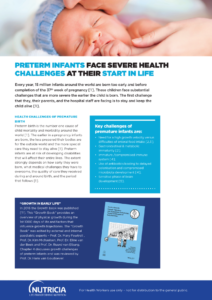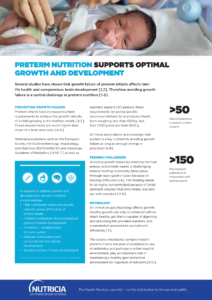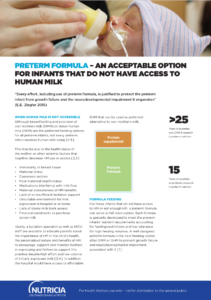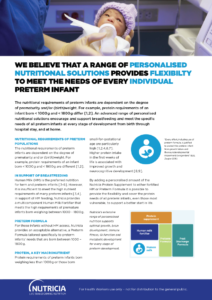The earlier an infant is born, the less prepared it is for the outside world and so the more special care it will need to stay alive.1Howson, et al (Eds.). Born Too Soon: The Global Action Report on Preterm Birth. 2012. World Health Organisation. Geneva, Switzerland. Published on 2012 The very particular challenges premature infants face include:
• A need for high velocity growth outside of the womb vs. immature gastrointestinal and metabolic systems2Agostoni, et al. J Pediatr Gastroenterol Nutr. Published on 2010;50(1):85-91. ,3Klein (Ed.), J Nutr, 2002;132(6 Suppl 1): Published on 1395S-1577S;11. 2002
• High nutrient requirements needed for growth vs a limited feeding volume tolerance,4Klein (Ed.), J Nutr, 2002;132(6 Suppl 1): Published on 1395S-1577S;11. 2002
• Immature/compromised immune system leaving infants susceptible to infections5Neu, (2014) 110: 253-263. In: Koletzko-Uauy-Pointdexter (Eds.) Nutritional care of preterm infants: Scientific basis and practical guidelines. Karger, Basel, Switzerland.. Published on 2014
• Growth deficits affecting functional organ development, including brain development6Ramel and Georgieff, World Rev Nutr Diet. Published on 2014;110:190-200
Preterm infants are at risk of disabilities that can affect their entire lives; the care an infant receives during and around birth and the period that follows is therefore of critical importance.
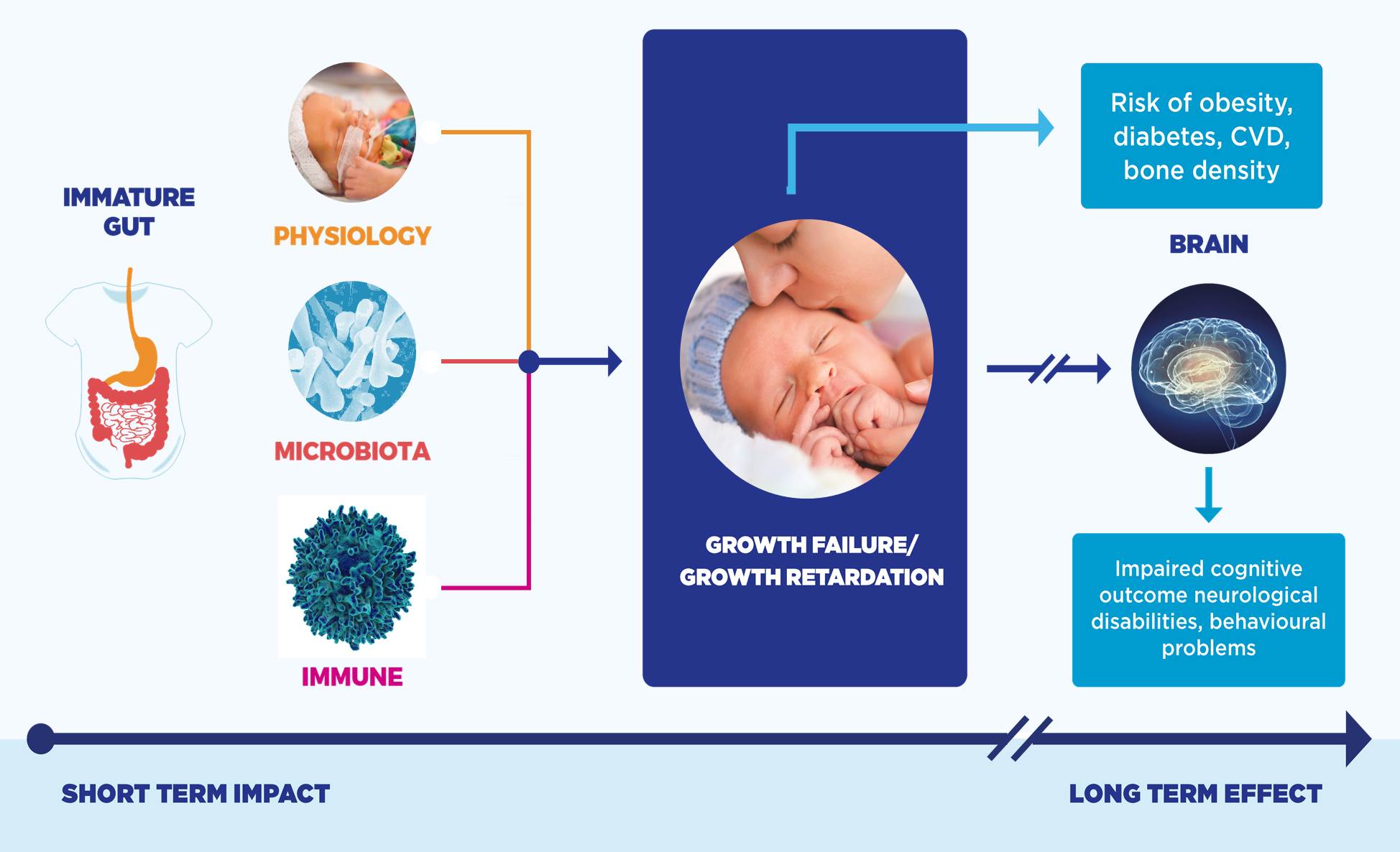
Preterm infants have specific nutritional requirements
The final trimester of pregnancy is a period of rapid physical growth for the infant; a rate of growth far greater than a preterm infant experiences outside of the womb. Missing this critical phase of intrauterine growth and development means that preterm infants face a difficult challenge to grow and develop at a similar pace to their term-born peers, resulting in increased nutritional requirements. Meeting these increased nutritional needs can have positive long-lasting effects on development, and can reduce the risk of developing non-communicable diseases in the future.9Klein (Ed.), J Nutr, 2002;132(6 Suppl 1): Published on 1395S-1577S;11. 2002 ,10Agostoni, et al. J Pediatr Gastroenterol Nutr. Published on 2010;50(1):85-91. ,11Vanhees, et al. Cell Mol Life Sci. Published on 2014;71(2):271-85 ,12Koletzko, Adv Exp Med Biol. Published on 2005;569:1-12 ,13Prince and Groh-Wargo, Nutr Clin Pract. Published on 2013;28(6):659-68

Breastfeeding and human milk offer the best nutrition for all infants; however for preterm infants, human milk from their mother is not always available, or may not be nutritionally sufficient, thus requiring fortification. When a mother’s own milk is unavailable, donor human milk or a preterm formula, is recommended.
Danone Research & Innovation has developed a range of nutritional solutions that encourage breastfeeding and at the same time meet the very specific nutritional needs of preterm infants. Our preterm formulas and human milk fortifiers support growth, immune health, gastrointestinal function, and metabolic and brain development.14American Academy of Pediatrics. Pediatrics, Published on 2012;129(3):e827-2841
These documents explain our belief that the right nutrition in the first 1000 days has the power to influence preterm infants’ health for life.
Learn more about the growth journey during the first crucial 1000 days and infant growth challenges here.
View References
| 1, 7 | Howson, et al (Eds.). Born Too Soon: The Global Action Report on Preterm Birth. 2012. World Health Organisation. Geneva, Switzerland. Published on 2012 |
|---|---|
| 2, 10 | Agostoni, et al. J Pediatr Gastroenterol Nutr. Published on 2010;50(1):85-91. |
| 3, 4, 9 | Klein (Ed.), J Nutr, 2002;132(6 Suppl 1): Published on 1395S-1577S;11. 2002 |
| 5 | Neu, (2014) 110: 253-263. In: Koletzko-Uauy-Pointdexter (Eds.) Nutritional care of preterm infants: Scientific basis and practical guidelines. Karger, Basel, Switzerland.. Published on 2014 |
| 6 | Ramel and Georgieff, World Rev Nutr Diet. Published on 2014;110:190-200 |
| 8 | http://www.who.int/mediacentre/factsheets/fs363/en/ |
| 11 | Vanhees, et al. Cell Mol Life Sci. Published on 2014;71(2):271-85 |
| 12 | Koletzko, Adv Exp Med Biol. Published on 2005;569:1-12 |
| 13 | Prince and Groh-Wargo, Nutr Clin Pract. Published on 2013;28(6):659-68 |
| 14 | American Academy of Pediatrics. Pediatrics, Published on 2012;129(3):e827-2841 |

